1995 GMC SIERRA oil pressure
[x] Cancel search: oil pressurePage 335 of 488
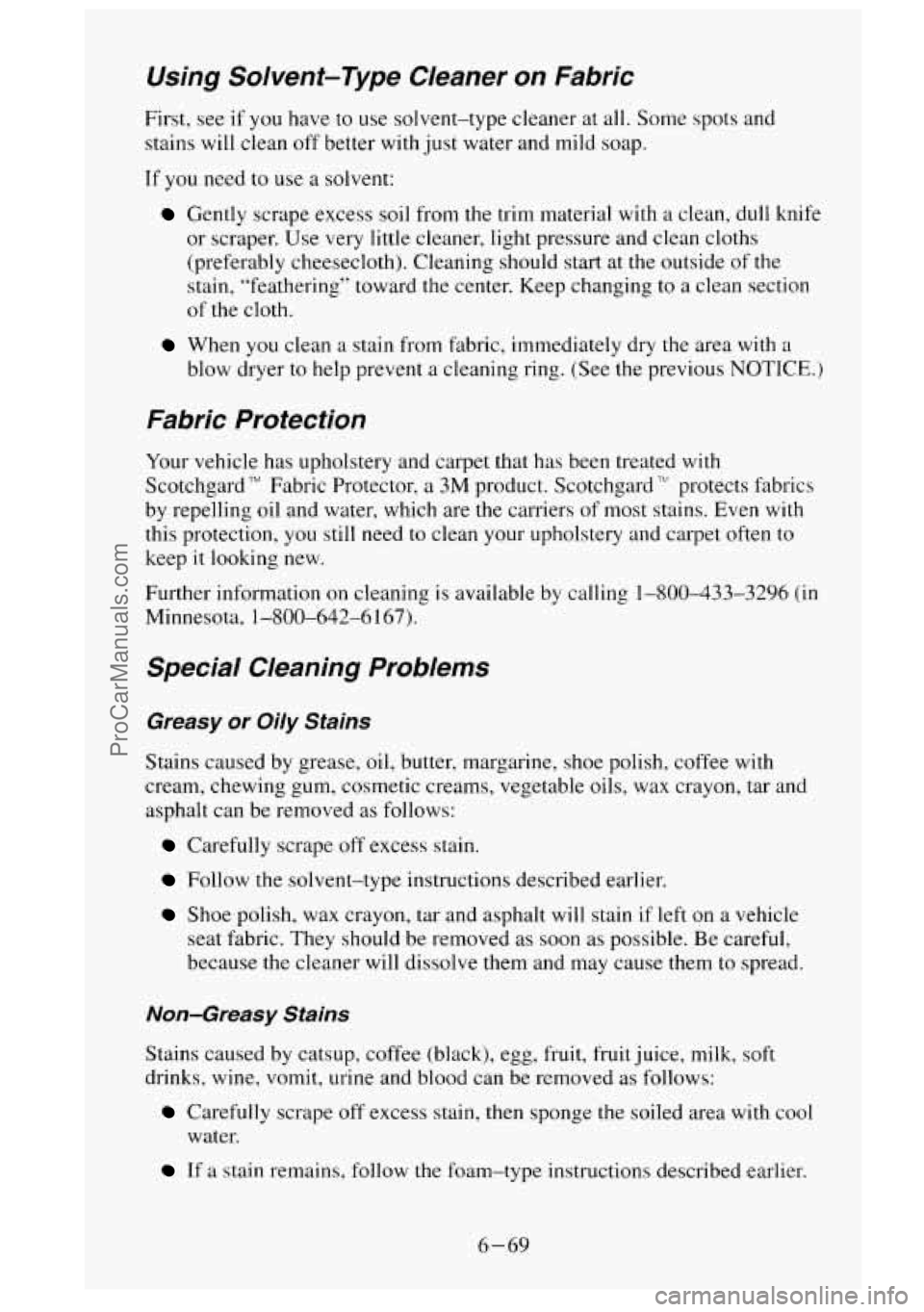
Using Solvent-Type Cleaner on Fabric
First, see if you have to use solvent-type cleaner at all. Some spots and
stains will clean
off better with just water and mild soap.
If you need to use a solvent:
Gently scrape excess soil from the trim material with a clean, dull knife
or scraper. Use very little cleaner, light pressure and clean cloths
(preferably cheesecloth). Cleaning should start at the outside of the
stain, “feathering” toward the center. Keep changing to
a clean section
of the cloth.
When you clean a stain from fabric, immediately dry the area with a
blow dryer to help prevent a cleaning ring. (See the previous NOTICE.)
Fabric Protection
Your vehicle has upholstery and carpet that has been treated with
Scotchgard TM Fabric Protector, a 3M product. Scotchgard TN protects fabrics
by repelling oil and water, which are the carriers of most stains. Even with
this protection, you still need to clean your upholstery and carpet often to
keep
it looking new.
Further information
on cleaning is available by calling 1-800-433-3296 (in
Minnesota, 1-800-642-6 167).
Special Cleaning Problems
Greasy or Oily Stains
Stains caused by grease, oil, butter, margarine, shoe polish, coffee with
cream, chewing gum, cosmetic creams, vegetable oils, wax crayon, tar and
asphalt can be removed as follows:
Carefully scrape off excess stain.
Follow the solvent-type instructions described earlier.
Shoe polish, wax crayon, tar and asphalt will stain if left on a vehicle
seat fabric. They should be removed as soon
as possible. Be careful,
because the cleaner will dissolve them and may cause them to spread.
Non-Greasy Stains
Stains caused by catsup, coffee (black), egg, fruit, fruit juice, milk, soft
drinks, wine, vomit, urine and blood can be removed as follows:
Carefully scrape off excess stain, then sponge the soiled area with cool
water.
If a stain remains. follow the foam-type instructions described earlier.
6-69
ProCarManuals.com
Page 338 of 488
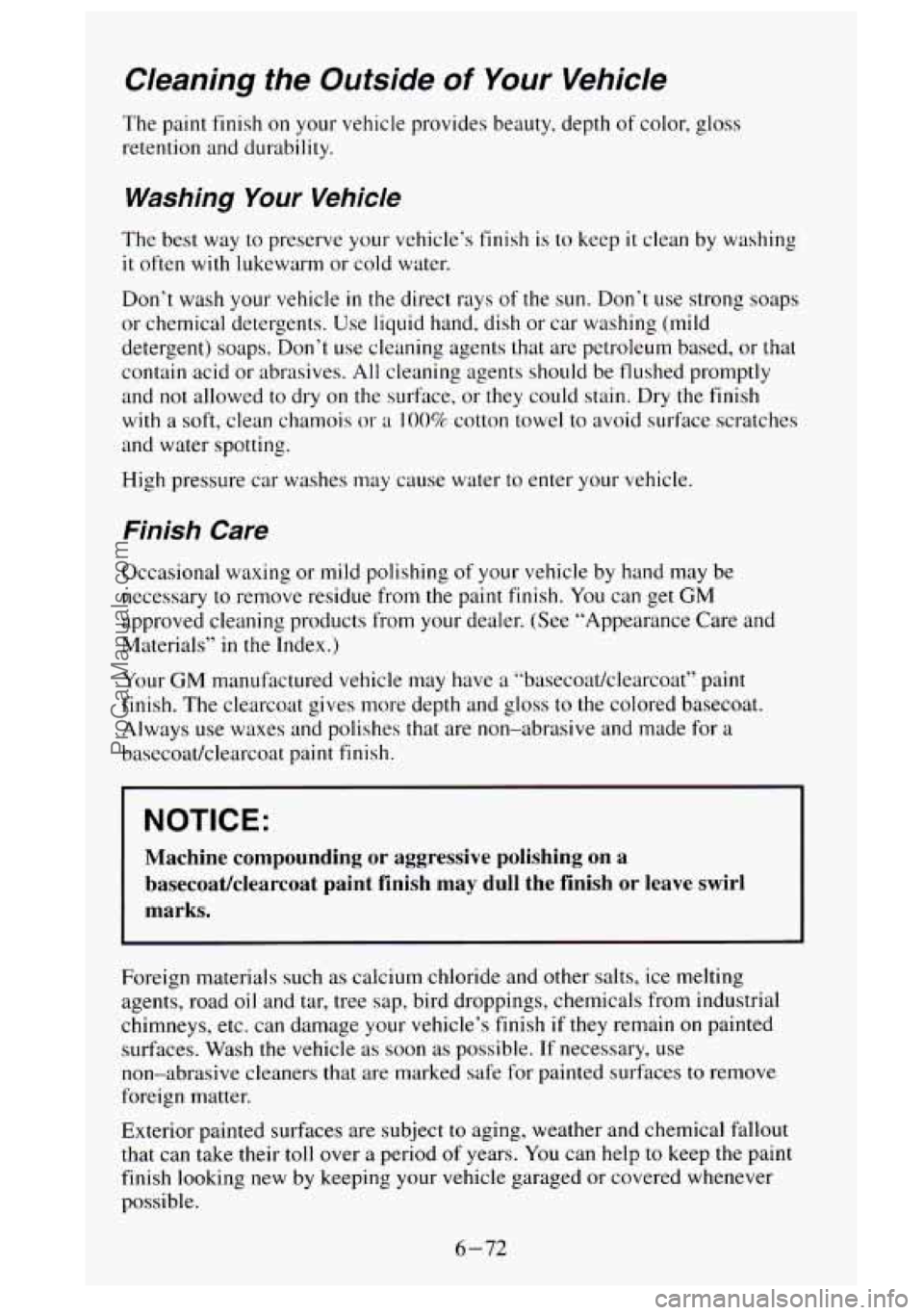
Cleaning the Outside of Your Vehicle
The paint finish on your vehicle provides beauty, depth of color, gloss
retention and durability.
Washing Your Vehicle
The best way to preserve your vehicle’s finish is to keep it clean by washing
it often with lukewarm or cold water.
Don’t wash your vehicle
in the direct rays of the sun. Don’t use strong soaps
or chemical detergents. Use liquid hand, dish or car washing (mild
detergent) soaps. Don’t use cleaning agents that are petroleum based, or that
contain acid or abrasives. All cleaning agents should be flushed promptly
and
not allowed to dry on the surface, or they could stain. Dry the finish
with a soft, clean chamois
or a 100% cotton towel to avoid surface scratches
and water spotting.
High pressure car washes may cause water to enter your vehicle.
Finish Care
Occasional waxing or mild polishing of your vehicle by hand may be
necessary
to remove residue from the paint finish. You can get GM
approved cleaning products from your dealer. (See “Appearance Care and
Materials” in the Index.)
Your
GM manufactured vehicle may have a ‘‘base~~at/~learcoat” paint
finish. The clearcoat gives more depth and gloss to the colored basecoat.
Always use waxes and polishes that are non-abrasive and made for a
basecoatklearcoat paint finish.
NOTICE:
Machine compounding or aggressive polishing on a
basecoatlclearcoat paint finish may dull the finish
or leave swirl
marks.
Foreign materials such as calcium chloride and other salts, ice melting
agents, road oil and tar, tree
sap, bird droppings, chemicals from industrial
chimneys, etc. can damage your vehicle’s
finish if they remain on painted
surfaces. Wash the vehicle as soon as possible. If necessary, use
non-abrasive cleaners that are
marked safe for painted surfaces to remove
foreign matter.
Exterior painted surfaces are subject
to aging, weather and chemical fallout
that can take their
toll over a period of years. You can help to keep the paint
finish looking new by keeping your vehicle garaged or covered whenever
possible.
6-72
ProCarManuals.com
Page 367 of 488
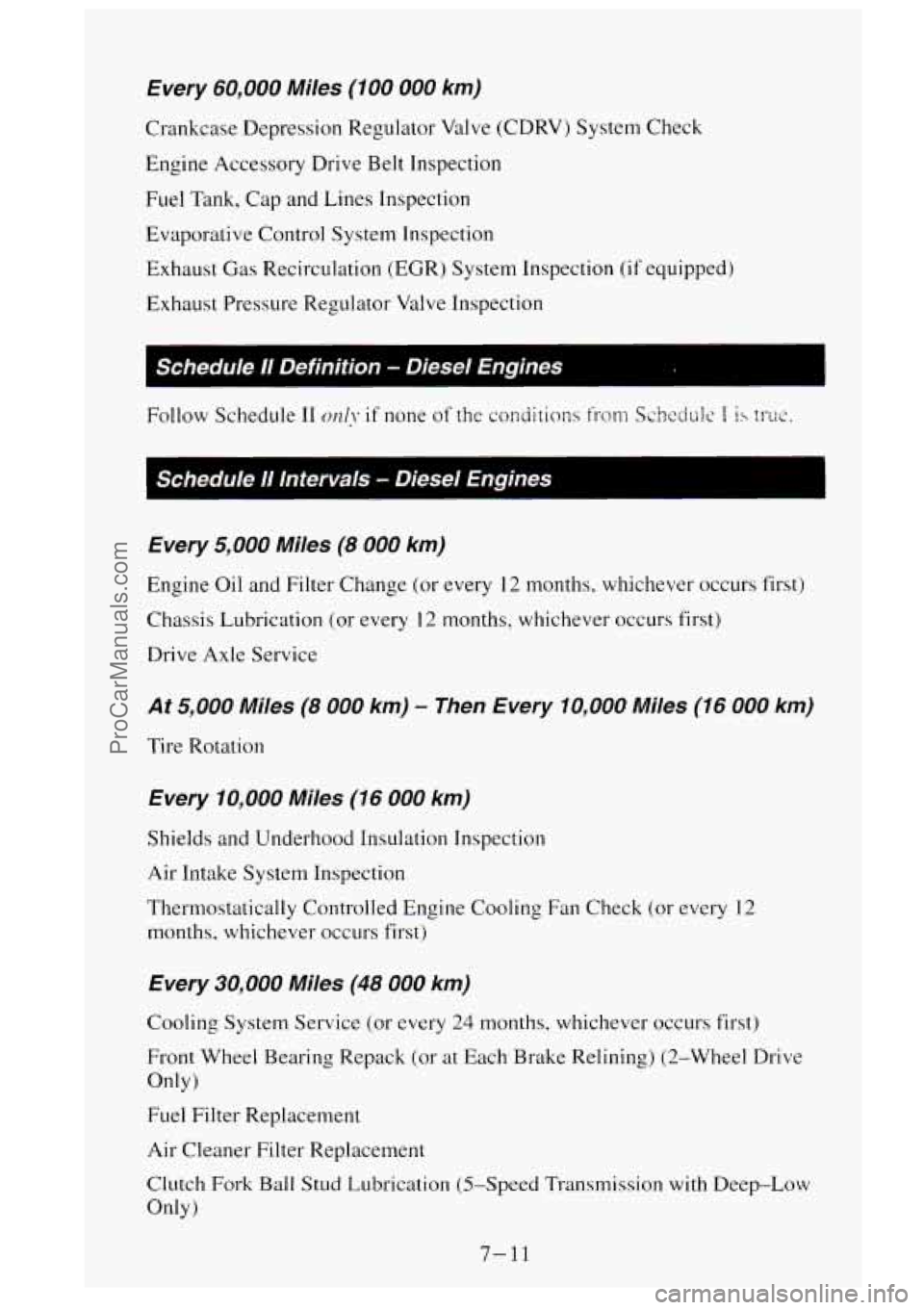
Every 60,000 Miles (100 000 km)
Crankcase Depression Regulator Valve (CDRV) System Check
Engine Accessory Drive Belt Inspection
Fuel Tank, Cap and Lines Inspection
Evaporative Control System Inspection
Exhaust Gas Recirculation (EGR) System Inspection
(if equipped)
Exhaust Pressure Regulator Valve Inspection
I Schedule 11 Definition - Diesel Engines
Follow Schedule II on!\- if none ofrhe conditions i'wm Schcdtilc I Is truc.
--
I Schedule I1 lntervals - Diesel Engines 1
Every 5,000 Miles (8 000 km)
Engine Oil and Filter Change (or every 12 months, whichever occurs first)
Chassis Lubrication
(or every 12 months, whichever occurs first)
Drive Axle Service
At 5,000 Miles (8 000 km) - Then Every 10,000 Miles (16 000 km)
Tire Rotation
Every 10,000 Miles (16 000 km)
Shields and Underhood insulation Inspection
Air Intake System Inspection
Thermostatically Controlled Engine Cooling Fan Check (or every
I2
months, whichever occurs first)
Every 30,000 Miles (48 000 km)
Cooling System Service (or every 24 months, whichever occurs first)
Front Wheel Bearing Repack (or
at Each Brake Relining) (2-Wheel Drive
Fuel Filter Replacement
Air Cleaner Filter Replacement
Clutch Fork Ball Stud Lubrication (5-Speed Transmission with Deep-Low
Only)
Only)
7-11
ProCarManuals.com
Page 368 of 488
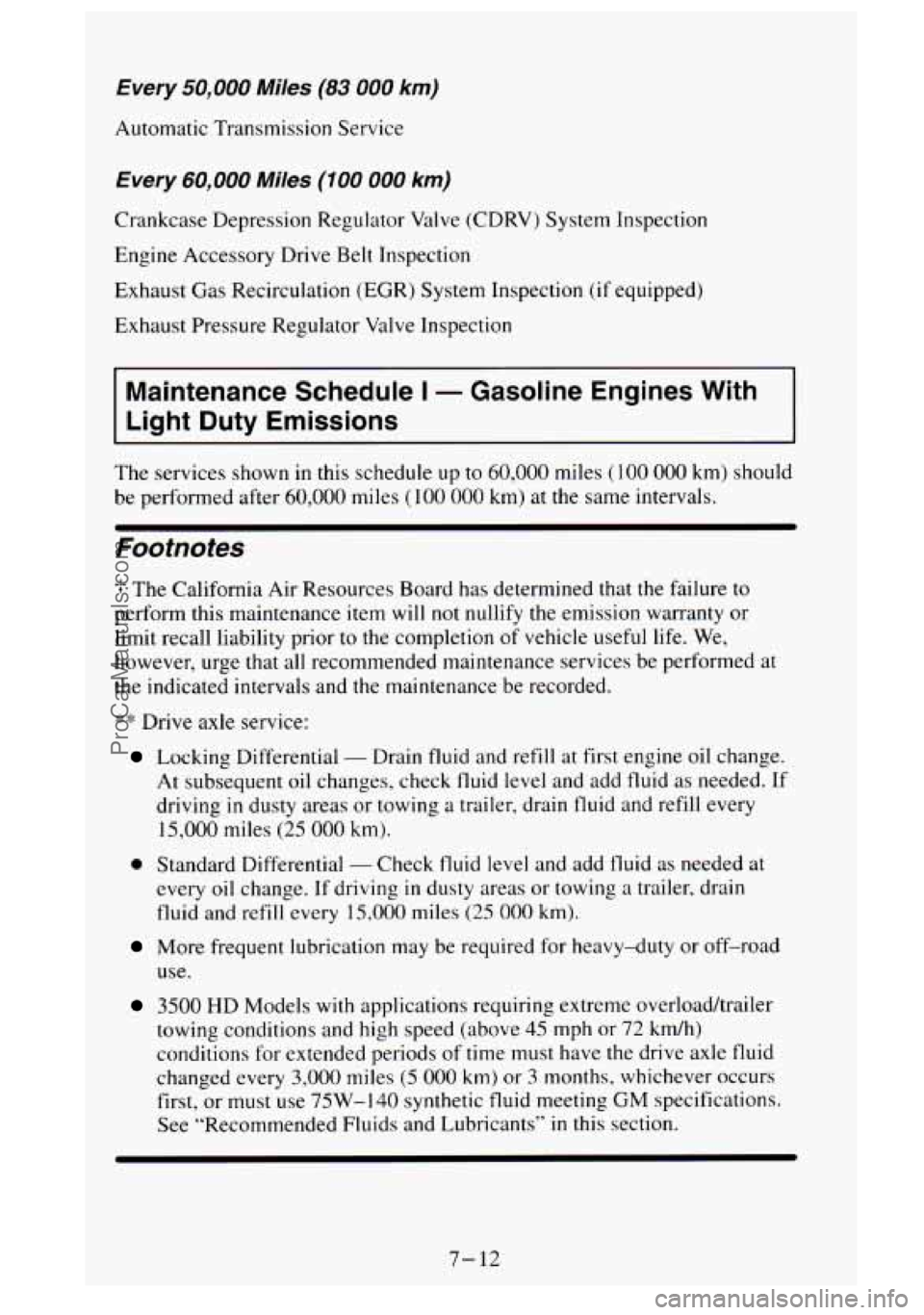
Every 50,000 Miles (83 000 km)
Automatic Transmission Service
Every 60,000 Miles (100 000 km)
Crankcase Depression Regulator Valve (CDRV) System Inspection
Engine Accessory Drive Belt Inspection
Exhaust Gas Recirculation (EGR) System Inspection
(if equipped)
Exhaust Pressure Regulator Valve Inspection
Maintenance Schedule I - Gasoline Engines With
Light
Duty Emissions
The services shown in this schedule up to 60,000 miles (1 00 000 km) should
be performed after
60,000 miles (100 000 km) at the same intervals.
Footnotes
3 The California Air Resources Board has determined that the failure to
perform this maintenance item will not nullify the emission warranty or
limit recall liability prior to the completion of vehicle useful life. We,
however, urge that all recommended maintenance services be performed at
the indicated intervals and the maintenance be recorded.
:$* Drive axle service:
Locking Differential - Drain fluid and refill at first engine oil change.
At subsequent oil changes, check fluid level and add fluid
as needed. If
driving in dusty areas or towing a trailer, drain fluid and refill every
15,000 miles (25 000 km).
0 Standard Differential - Check fluid level and add fluid as needed at
every oil change.
If driving in dusty areas or towing a trailer, drain
fluid and refill every 15,000 miles (25 000 km).
More frequent lubrication may be required for heavy-duty or off-road
use.
3500 HD Models with applications requiring extreme overload/trailer
towing conditions and high speed (above
45 mph or 72 kmh)
conditions for extended periods of time must have the drive axle fluid
changed every
3,000 miles (5 000 km) or 3 months, whichever occurs
first, or must use
75W-140 synthetic fluid meeting GM specifications.
See “Recommended Fluids and Lubricants”
in this section.
7-12
ProCarManuals.com
Page 375 of 488

LI
c
Maintenance Schedule I - Gasoline Engines With
Light Duty Emissions
(Contimed)
Drain, flush and refill cooling system (or every 24 months, whichever
occurs first). See "Engine Coolant''
in the lndex for what to use.
Inspect hoses. Clean radiator. condenser. pressure cap and neck.
Pressure test
the cooling system and pressure cap. An Emission Control
Service.
For 2-Wheel Drive vehicles only: Clean and repack the front wheel
bearings (or at each brake relining, whichever occurs first).
Replace spark plugs.
An E~~zissior~ Corztrol Ser-vice.
Replace air cleaner filter. Replace filter more often under dusty
conditions.
An Emission Cor~tr-01 Service.
Rotate tires. See "Tire Inspection and Rotation" in the lndex for proper
rotation pattern and additional information.
I DATE I ACTUAL MILEAGE I SERVICED BY:
33,000 Miles (55 000 km)
0 Change engine oil and filter (or every 3 months, whichever occurs
first).
An Er7rissiou Contmi Service.
0 Lubricate the front suspension, king pin bushings, steering linkage,
transmission shift linkage, transfer case shift linkage, parking brake
cable guides, rear driveline center splines, front axle propshaft splines,
brake pedal springs and clutch pedal springs.
Ball joints and king pin
bushings should not be lubricated unless their temperature is
10" F
(-I 2" C), or higher. When weather is cold, let the ball joints and king
pin bushings warm up before lubrication or they could be damaged.
Perform
each of the listed lubrication service items at this mileage
interval (or every
6 months, whichever occurs first).
ProCarManuals.com
Page 382 of 488

60,000 Miles (100 000 km)
c;
0
0
0
il
0
Change engine oil and filter (or every 3 tnonths. whichever occurs
first).
AI? Emission Control Service.
Lubricate the front suspension. king pin bushings, steering linkage,
transmission shift linkage, transfer case shift linkage, parking brake
cable guides, rear driveline center splines. front axle propshaft splines.
brake pedal springs and clutch pedal springs. Ball joints and king
pin
bushings should not be lubricated unless their temperature is 10" F
(-12" C), or higher. When weather is cold, let the ball joints and king
pin bushings warm up before lubrication or they could be damaged.
Perform each of the listed lubrication service items at this mileage
interval (or every
6 months, whichever occurs first).
Check rear/fi-ont axle fluid level and add fluid as needed. Check
constant
-\;elociry joint5 and axle seals for leaking.';'';'
For 2-Wheel Drive vehicles only: Clean and repack the front wheel
bearings (or at each brake relining, whichever occurs first).
Inspect engine accessory drive belt.
An Emissiolz Comrol Ssrvice.
Drain, flush and refill cooling system (or every 24 months, whichever
occurs first). See "Engine Coolant"
in the lndex for what to use.
Inspect hoses. Clean radiator, condenser, pressure cap and neck.
Pressure test the cooling system and pressure cap.
,411 Erltission Control
Service.
Replace spark plugs. AI? Emission Control Service..
Replace air cleaner filter. Replace filter more often under dusty
conditions.
Arz Emission Colztrol Service.
Inspect fuel tank, cap and lines for damage or leaks . Inspect fuel cap
gasket for any damage. Replace parts as needed.
A17 E~nission Control
Service. -i-
7-26
ProCarManuals.com
Page 386 of 488

0
0
0
0
0
Check readfront axle fluid level and add fluid as needed. Check
constant velocity joints and axle seals for leaking.*’*’
For 2-Wheel Drive vehicles only: Clean and repack the front wheel
bearings (or at each brake relining, whichever occurs first).
Drain, flush and refill cooling system (or every
24 months, whichever
occurs first). See “Engine Coolant”
in the Index for what to use.
Inspect hoses. Clean radiator, condenser, pressure cap and neck.
Pressure test the cooling system and pressure cap.
AI1 Emissiorr Cor?tro/
Se n?ic.e.
Replace spark plugs. Au Emissiorz Control Senice.
Replace air cleaner filter. An Emissiorl Cofltrol Service.
DATE SERVICED BY: ACTUAL
MILEAGE I
37,500 Miles (62 500 km)
0 Change engine oil and filter (or every 12 months, whichever occurs
first).
An EmissioM Control SorLice.
0 Lubricate the front suspension, king pin bushings, steering linkage,
transmission shift linkage, transfer case shift linkage, parking brake
cable guides, rear driveline center splines. front axle propshaft splines,
brake pedal springs and clutch pedal springs. Ball joints and king pin
bushings should
not be lubricated unless their temperature is 10” F
(-12” C), or higher. When weather is cold, let the ball joints and king
pin bushings warm
up before lubrication or they could be damaged.
Perform each of the listed lubrication service items at this mileage
interval
(or every 12 months, whichever occurs first).
7-30
ProCarManuals.com
Page 389 of 488
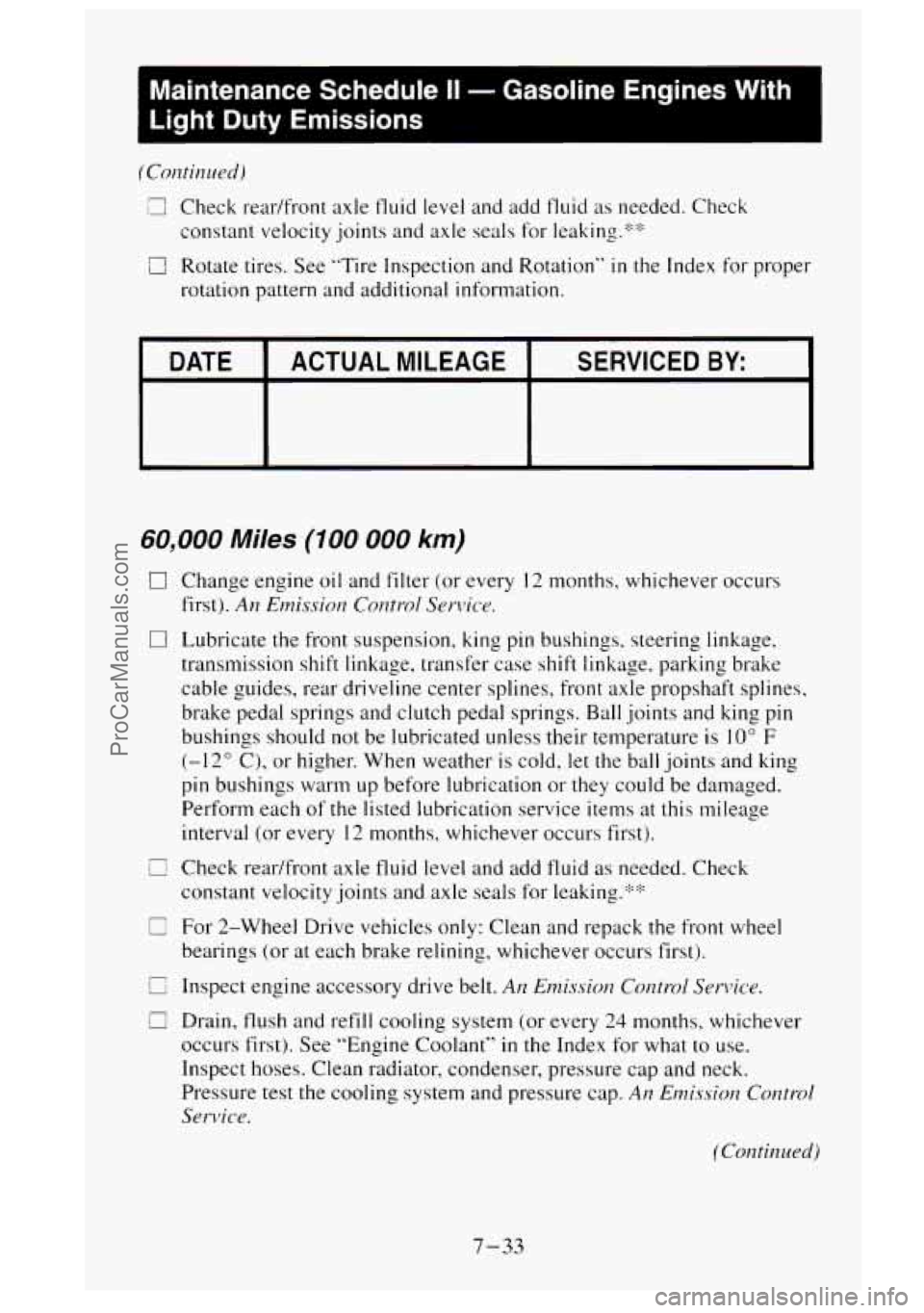
Maintenance Schedule I1 - Gasoline Engines With
Light Duty Emissions
(Continued)
E Check rear/front axle fluid level and add fluid as needed. Check
constant velocity joints and axle seals for leaking.:!::!:
3 Rotate tires. See "Tire Inspection and Rotation" in the Index for proper
rotation pattern and additional information.
DATE SERVICED BY: ACTUAL MILEAGE L
60,000 Miles (100 000 km)
0
n
C
El
Change engine oil and filter (or every 12 months, whichever occurs
first).
An Emission Control Service.
Lubricate the front suspension, king pin bushings. steering linkage,
transmission shift linkage, transfer case shift linkage, parking brake
cable guides, rear driveline center splines, front axle propshaft splines,
brake pedal springs and clutch pedal springs. Ball joints and king pin
bushings should not be lubricated unless their temperature is
10" F
(-12" C), or higher. When weather is cold, let the ball joints and king
pin bushings warm up before lubrication or they could be damaged.
Perform each
of the listed lubrication service items at this mileage
interval (or every
12 months. whichever occurs first).
Check readfront axle fluid level and add fluid as needed. Check
constant velocity joints and axle seals for leaking.'%*
For 2-Wheel Drive vehicles only: Clean and repack the front wheel
bearings
(or at each brake relining, whichever occurs first).
Inspect engine accessory drive belt.
An Enzission Control Senice.
Drain, flush and refill cooling system (or every 24 months, whichever
occurs first). See "Engine Coolant"
in the Index for what to use.
Inspect hoses. Clean radiator, condenser, pressure cap and neck.
Pressure test the cooling system and pressure cap.
AH Emissio~ Control
Service.
7-33
ProCarManuals.com